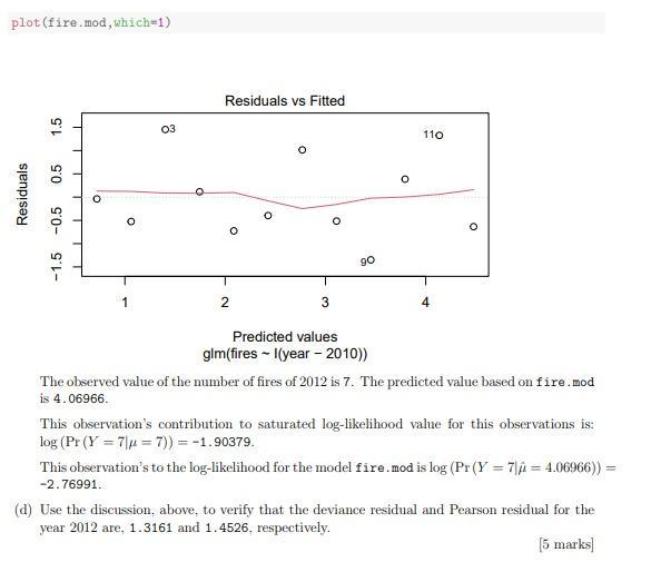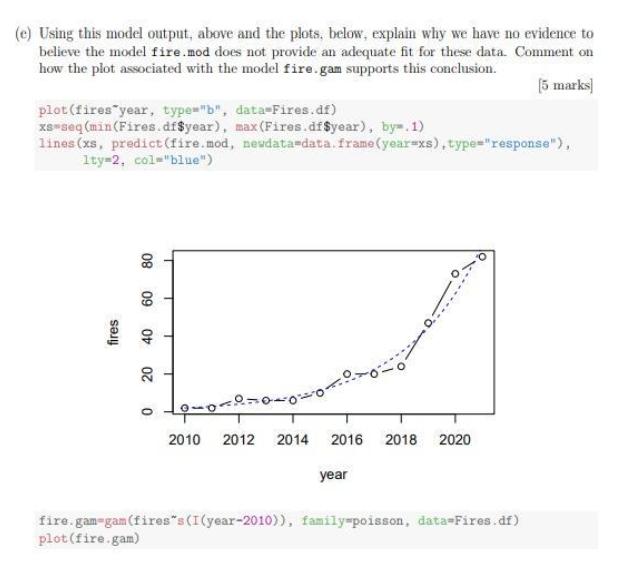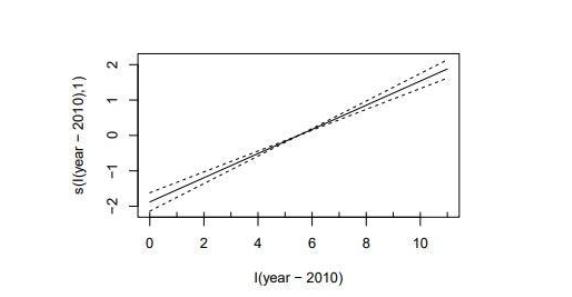Answered step by step
Verified Expert Solution
Question
1 Approved Answer
The data below is motivated by a New Zealand Listener magazine article (Septem- ber 25 2021) about the the number of reported fire incidents




The data below is motivated by a New Zealand Listener magazine article (Septem- ber 25 2021) about the the number of reported fire incidents related to lithium-ion batteries. Lithium-ion batteries charge mobile-phones, lap-top computers, electric vehicles, and many of other electronic devices. The data in the data-frame Fires.df consists of: fires the number of reported fires due to lithium-ion batteries the year these incidents were recorded (2010-2021). year The following plot was obtained: Consider the model and output below (which, unfortunately, has been stained by tomato sauce when your lecturer ate a meat pie clumsily): fire.mod gim (fires I(year-2010), family-poisson, data-Fires.df) summary(fire.mod) $coef Estimate Std. Error z value Pr (>Izl) 0.72061 0.214106 ## ## (Intercept) ## I(year 2010) 0.34147 0.023571, 1-pchisq (deviance (fire.mod), df.residual (fire.mod)) ## [1] 0.60597 7.6357e-04 1.46316-47 plot (fire.mod, which=1) Residuals 1.5 0.5 -0.5 -1.5 03 Residuals vs Fitted O 2 3 Predicted values glm(fires - I(year - 2010)) 110 O The observed value of the number of fires of 2012 is 7. The predicted value based on fire.mod is 4.06966. This observation's contribution to saturated log-likelihood value for this observations is: log (Pr (Y=7] = 7)) = -1.90379. This observation's to the log-likelihood for the model fire.mod is log (Pr (Y=7=4.06966)) = -2.76991. (d) Use the discussion, above, to verify that the deviance residual and Pearson residual for the year 2012 are. 1.3161 and 1.4526, respectively. [5 marks] (e) Using this model output, above and the plots, below, explain why we have no evidence to believe the model fire.mod does not provide an adequate fit for these data. Comment on how the plot associated with the model fire.gam supports this conclusion. [5 marks] plot (fires year, type="b", data-Fires.df) xs-seq (min (Fires.df$year), max (Fires.df$year), by-.1) lines (xs, predict (fire.mod, neudata-data.frame(year-xs), type="response"), 1ty=2, col="blue") 80 60 20 0 -0-0-0-0 O year a. 2010 2012 2014 2016 2018 2020 fire.gam-gam(fires s (I(year-2010)), family-poisson, data-Fires.df) plot (fire.gam) s(l(year-2010),1) 2 1 0 -2 -1 02 4 6 8 I(year - 2010) 10
Step by Step Solution
★★★★★
3.48 Rating (151 Votes )
There are 3 Steps involved in it
Step: 1
Decrease in cash 2970000 1150000 1820000 New current ratio Current assets decrease in cash Current l...
Get Instant Access to Expert-Tailored Solutions
See step-by-step solutions with expert insights and AI powered tools for academic success
Step: 2

Step: 3

Ace Your Homework with AI
Get the answers you need in no time with our AI-driven, step-by-step assistance
Get Started


